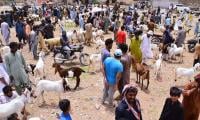Our shut-open-shut border policy towards Afghanistan needs a serious review. More than a review, it needs context, aim-identification and proper juxtaposition within our long-term strategic worldview.
We ought to have some sense of where we are going with the present set of steps vis-a-vis Afghanistan, and whether, in the medium and long terms, these steps will be in alignment with how we want to see our ties shape up with this important yet troublesome state.
That we had to do something when gangs from across the border attacked our cities and sent in terrorists who killed our precious women, children and men was pretty much a foregone conclusion. No less obvious was what needed to be done: we had to send a signal to Kabul that it had to somehow control these gangs or else be penalised.
Closing the border was a people-centered punishment and knocking out hideouts was a state-centered action. Both combined did produce the result of getting Kabul to focus its attention on the fact that its territory was producing terrorism that was intolerable and for which our patience was running out.
Also the new army chief, General Qamar Javed Bajwa, didn’t have to consult anyone and could order forces to pound potential and actual sanctuaries. The display of a quick response and the consistency of its use – despite protests, threats and diplomatic theatrics from Kabul – indicated that a new normal had been introduced in our equation with Afghanistan: the gloves will come off easily every time we suspect or have information about terrorists operating out of Afghanistan who strike inside our country. This policy also keeps the option of a hot pursuit on the table just to reinforce the message that the old ‘talk, talk and no action’ phase is over.
However, having introduced this new element in our relationship with Afghanistan, we need to now consider how these strong-arm actions fit into the larger framework of our ties with a country whose internal happenings have a direct bearing on our core security goals. There is no embarrassment in admitting the fact that these steps towards Afghanistan – the use of force to convey our anger and anguish – have been taken in haste. They became inevitable after the wave of terror that had taken everybody in the country by surprise and had engendered fears that perhaps we could descend into the Middle East-like chaos. But now that these steps have been taken, they have to be squared with the needs of our long-term ties with Afghanistan.
Clearly we don’t want a hostile, embittered Afghanistan whose government – regardless of how compromised and weak it may be – is able to sell to a willing public the idea that Pakistan is an enemy state. We also don’t want the dynamics of trade between the two countries to be so badly affected that the scope of it is reduced rather than enhanced. We certainly don’t want the population across immediate border towns – whose livelihood and economy depends crucially on the flexibility of to-and-fro movement – to become agitated and hostile.
With these ‘don’ts’ in mind, it is only logical to suggest that restriction across the border – from legitimate to illegal crossings– must not be used as a favourite tool to express diplomatic or military displeasure. People-to-people hostility runs counter to the idea that this border needs to be kept calm and the population in its immediate vicinity must be reasonably assured that they won’t pick the cost of the dark deeds of terrorists. Of course, border crossings should be more tightly regulated. Border fencing is a great idea and must be followed up without any reservation or second thoughts. Indeed, in times of threats or heightened frustration – with Kabul’s insouciance towards our suffering and pain at the hands of terrorists – these crossings can be paced down. But to shut them down at the drop of a hat is a policy that does not serve any long-term purpose.
Also, carrying out strikes across the border on sanctuaries will remain a policy of somewhat limited and diminishing gains as gangs operating from across could easily shift their bases inward or relocate to another position of advantage. Their existence – especially since it is bankrolled by India and some Western intelligence agencies apart from Kabul’s own intel apparatus – is not meant to be a stop-gap arrangement. It is a long-term plan to stir mischief in Pakistan and to stretch the army’s resources from east to west. So, in all probability, these groups will stay there – all the more because Kabul, by its own admission and by our own acknowledgement, continues to insist that it has no writ over these havens.
This creates the policy challenge of making a demand on Kabul through punitive action that we know it cannot (or will not) fulfil. How do we enhance our capacity to stop these gangs from making it across the border and striking in the mainland? We cannot be lobbing off mortars and pretend that all of them are demolishing terrorists bases. We, therefore, need to seriously work on fixing our border by fencing it and also by building a strong and robust special border force – the foundation of which is already available in the shape of the Frontier Corps.
The FC needs to be developed as a defence and sword arm of the nation for our border with Afghanistan. It is a motivated force with remarkable achievements under its belt in the first and most complex phase of Fata operations. If it wasn’t for its contributions, the vast stretches of Fata where we raise the national flag now would still have been out of our reach. It needs to be equipped, financed and its command structure must be adjusted to the new role.
Equally important is the work on and with the tribes that straddle the border or are in close proximity to the border. History suggests that these tribes are as much a first line of defence for us as they are potential transmission belts of trouble that travels down the way the Kabul River flows. Some of these tribes – such as Salarzai in Bajaur – were bedrocks against mass-scale Taliban raids and paid a heavy price for standing for a terror-free country. We used them as tribal lashkars and then, at the first light of the dawn of Taliban defeat, abandoned them. This was pathetic. These tribes need to be engaged – not to start a new phase of lashkar raising but to build a common cause of monitoring, supervision and effective people-driven control of the border. Informal trade (let us not call it smuggling) will always allow the possibility of miscreants slipping in. But that in no way should stand in the path of building a human fence against organised raiders. This needs to be done quickly and with sincerity of purpose that goes beyond grabbing headlines and photo opportunities.
But, in the end, all these measures will not be effective in dealing with the Afghanistan challenge if we do not activate the diplomatic front at all levels. Bombs and guns are instruments of violence from which lasting peace can only emerge if the opponent is completely vanquished. In situations where total victory isn’t possible, kinetic means become long-term nightmares.
Pakistan stands to suffer the most from a breakdown of ties with Afghanistan. We have sent the right signals to Kabul and to the world through our border closure and strikes on sanctuaries. Now diplomatic channels need to be activated to arrest Afghanistan’s general drift towards chaos which can be evidenced by the Daesh attack on the Kabul military hospital. We need to take the lead on bilateral, trilateral, quadrilateral, and multilateral engagements to discuss and debate Afghanistan’s situation.
We have wasted too much time waiting for the Taliban to arrive on the table and have reduced the vast spectrum of Afghanistan’s diplomacy to the keyhole of delivering ‘good Taliban’ – a holy grail that is not in sight.
Let us redefine the parameters of peace in Afghanistan by expanding the diplomatic horizons and making a serious concerted pitch for some stability and sanity in our soft underbelly. Without the conflict ending on Afghan soil, our border management efforts will remain a mere firefight and have to be the main goal of our Afghanistan policy which we need to pursue relentlessly.
The writer is former executive editor of The News and a senior journalist with Geo TV.
Email: syedtalathussain@gmail.com
Twitter: @TalatHussain12
People stand in line up as election officials check their ballot papers during voting general election at a polling...
Women show their voter identity cards as they stand in a queue before casting their votes in Agartala. — PTIThe 18th...
Former prime minister Imran Khan. — Instagram/ imrankhan.ptiAn old saying has it that “when you dance with the...
Kashmiris in Indian illegally occupied Kashmir protesting against the Indian occupation as the forces of India looked...
A representational image showing residents walking at a wholesale market in Karachi. — AFP/FileOnce again there is...
A representational image showing late Pakistani human rights activist and Supreme Court lawyer Asma Jahangir. —...







